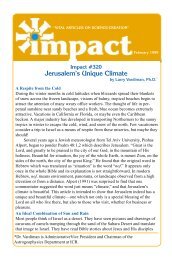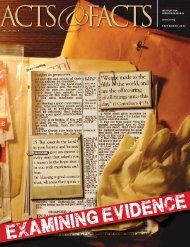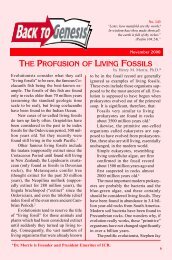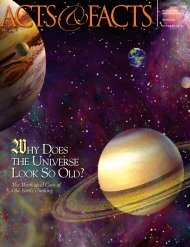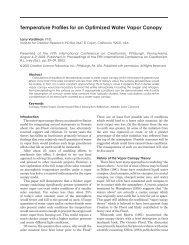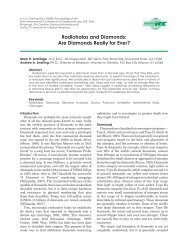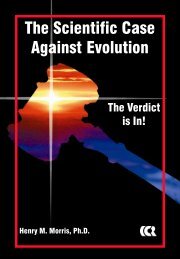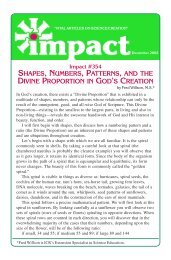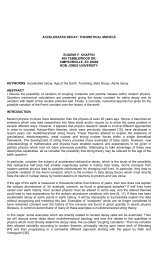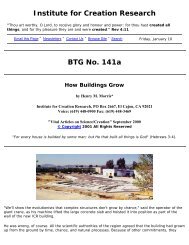radioisotopes and the age of the earth - Institute for Creation Research
radioisotopes and the age of the earth - Institute for Creation Research
radioisotopes and the age of the earth - Institute for Creation Research
You also want an ePaper? Increase the reach of your titles
YUMPU automatically turns print PDFs into web optimized ePapers that Google loves.
INTERMEDIATE RESULTS OF RATE RESEARCHHelium Diffusion – Dr. D. Russell Humphreys, PITwo decades ago, it was reported by Gentry et al. [6] that up to 58% <strong>of</strong> <strong>the</strong> helium (a daughter product<strong>of</strong> uranium <strong>and</strong> thorium decay) generated during <strong>the</strong> alleged 1.5 billion year <strong>age</strong> <strong>of</strong> <strong>the</strong> Precambriangranodiorite beneath <strong>the</strong> Jemez Mountains near Los Alamos, New Mexico, was still in <strong>the</strong> zirconsembedded in <strong>the</strong> biotite crystals contained within <strong>the</strong> granodiorite. Yet, <strong>the</strong> zircons were so small (seeFig. 1 <strong>for</strong> a picture <strong>of</strong> typical zircons) that <strong>the</strong>y should not have retained <strong>the</strong> helium <strong>for</strong> even a smallfraction <strong>of</strong> that time. The high retentions suggest to us <strong>and</strong> many o<strong>the</strong>r creationists that <strong>the</strong> helium hasnot had time to diffuse out <strong>of</strong> <strong>the</strong> zircons – that accelerated nuclear decay produced over a billion yearsworth <strong>of</strong> helium only thous<strong>and</strong>s <strong>of</strong> years ago. Such accelerated decay could reduce <strong>the</strong> radiometric timescale from gigayears down to months.Figure 1. Zircons from <strong>the</strong> Muav Tuff, Gr<strong>and</strong> Canyon, Arizona (Courtesy <strong>of</strong> Geotrack InternationalLaboratory).A <strong>the</strong>oretical creationist model, based on observed helium retention, <strong>of</strong> diffusion rates <strong>of</strong> helium over aperiod <strong>of</strong> 6,000 years was reported by Humphreys [8] <strong>and</strong> Humphreys et al. [9]. It compares well withlaboratory measurements in Jemez zircons, as shown in Fig. 2. The solid dots show <strong>the</strong> diffusioncoefficient as a function <strong>of</strong> inverse temperature <strong>for</strong> <strong>the</strong> measurements with <strong>the</strong> Jemez zircons <strong>and</strong> <strong>the</strong>solid lines through empty squares show <strong>the</strong> <strong>the</strong>oretical predictions from <strong>the</strong> <strong>the</strong>oretical model. There isa five-order-<strong>of</strong>-magnitude difference (100,000x) between <strong>the</strong> predictions <strong>of</strong> diffusion <strong>for</strong> <strong>the</strong> evolutionist<strong>and</strong> creationist models. The measured diffusion rates <strong>of</strong> He predict that helium would leak out <strong>of</strong> azircon/biotite matrix in a period <strong>of</strong> time on <strong>the</strong> order <strong>of</strong> thous<strong>and</strong>s <strong>of</strong> years, not hundreds <strong>of</strong> millions <strong>of</strong>years. This is consistent with <strong>the</strong> high concentrations <strong>of</strong> helium still found in <strong>the</strong> Jemez granodiorite.Additional laboratory measurements <strong>and</strong> modeling studies <strong>of</strong> helium diffusion in zircon are expected tolead to a fur<strong>the</strong>r refinement <strong>of</strong> <strong>the</strong> creationist model. The data <strong>of</strong> Fig. 2 indicate an <strong>age</strong> between 4,000<strong>and</strong> 14,000 years since <strong>the</strong> helium began to diffuse from <strong>the</strong> zircons. This is far short <strong>of</strong> <strong>the</strong> 1.5 billionyear evolutionist <strong>age</strong>! We believe that <strong>the</strong> final results will resoundingly support our hypo<strong>the</strong>sisconcerning diffusion <strong>and</strong> radiogenic helium.
Figure 2. Plot <strong>of</strong> diffusion coefficient <strong>of</strong> He in zircon vs. inverse temperature.Nuclear Decay Theory – Dr. Eugene F. Chaffin, PIThe quantum <strong>the</strong>ory <strong>of</strong> alpha <strong>and</strong> beta decay are being reviewed by Chaffin [2,3], with extensions <strong>of</strong> <strong>the</strong>st<strong>and</strong>ard models being explored to see if <strong>the</strong>y could lead to accelerated decay during episodic variations<strong>of</strong> <strong>the</strong> coupling constants. Variations in <strong>the</strong> radii <strong>of</strong> compactified extra dimensions <strong>and</strong> consequentvariation in coupling constants over <strong>the</strong> history <strong>of</strong> <strong>the</strong> universe could cause accelerated decay. If, duringearly creation week, say <strong>the</strong> first 2+ days be<strong>for</strong>e <strong>the</strong> creation <strong>of</strong> plants, such variations were to occur,<strong>the</strong>y could lead to accelerated nuclear decay, thus adjusting isotopic abundances, without givingunacceptable doses <strong>of</strong> radiation to life. Part way through day 3, God created grasses, herbs, <strong>and</strong> fruittrees which could have been dam<strong>age</strong>d by high radiation. Or, during <strong>the</strong> Fall <strong>of</strong> Genesis 3, or during <strong>the</strong>Genesis Flood, smaller variations are possible.These variations may help explain <strong>the</strong> abundances <strong>of</strong> <strong>radioisotopes</strong>, including radioactive equilibriumfound in decay chains such as <strong>the</strong> uranium series, within <strong>the</strong> young-<strong>earth</strong> timeframe. We are alsoexploring <strong>the</strong> tunneling <strong>the</strong>ory <strong>of</strong> alpha decay to see how much change in half-life is possible withoutdrastically affecting o<strong>the</strong>r measurable properties <strong>of</strong> nuclei. For only slight changes in <strong>the</strong> depth <strong>of</strong> <strong>the</strong>nuclear potential well (see Fig. 3), abrupt changes in <strong>the</strong> number <strong>of</strong> nodes <strong>of</strong> <strong>the</strong> alpha particle wavefunction occur which can lead to drastic changes in half-life. Also, <strong>the</strong> half-life depends exponentially on<strong>the</strong> shape <strong>of</strong> <strong>the</strong> potential well, so that even slight changes are effective in accelerating alpha-decay.Figure 3. Plot <strong>of</strong> nuclear potential energy vs. radial distance from <strong>the</strong> center <strong>of</strong> a nucleus.
Radiohalos – Dr. Andrew A. Snelling, PIThe significance <strong>of</strong> radiohalos is due to <strong>the</strong> fact <strong>the</strong>y represent a physical, integral historical record <strong>of</strong> <strong>the</strong>decay <strong>of</strong> <strong>radioisotopes</strong> in <strong>the</strong> radiocenters over a period <strong>of</strong> time as discussed by Snelling [17] <strong>and</strong>Snelling <strong>and</strong> Armit<strong>age</strong> [20]. The darkening <strong>of</strong> <strong>the</strong> minerals surrounding <strong>the</strong> radiocenters is caused bydam<strong>age</strong> to <strong>the</strong>ir crystal structure by alpha particles produced by nuclear decay. As part <strong>of</strong> a systematicef<strong>for</strong>t to investigate radiohalo occurrences in granitic rocks globally <strong>and</strong> throughout <strong>the</strong> geologic record,suitable samples have been collected from <strong>the</strong> La Posta (sou<strong>the</strong>rn Cali<strong>for</strong>nia), Stone Mountain (nearAtlanta, Georgia) <strong>and</strong> Cooma (sou<strong>the</strong>rn New South Wales, Australia) plutons.The biotite crystals in all <strong>the</strong>se granites contain abundant 238 U, 210 Po, <strong>and</strong> 214 Po radiohalos. Theoccurrence ratio is approximately five 210 Po radiohalos <strong>for</strong> every 214 Po <strong>and</strong> 238 U radiohalo, which occurroughly in equal numbers except in <strong>the</strong> Cooma pluton (see Fig. 4). While <strong>the</strong>se radiohalos arehomogeneously distributed throughout <strong>the</strong> mineralogically uni<strong>for</strong>m Stone Mountain pluton, <strong>the</strong>y arealmost exclusively concentrated in <strong>the</strong> muscovite-biotite granodiorite core <strong>of</strong> <strong>the</strong> La Posta pluton.Fur<strong>the</strong>rmore, <strong>the</strong>re are four to five times more <strong>of</strong> all <strong>the</strong>se radiohalos in <strong>the</strong> associated late-st<strong>age</strong>, IndianHills granite (sou<strong>the</strong>rn Cali<strong>for</strong>nia).Figure 4. Number <strong>of</strong> radiohalos vs. type <strong>and</strong> location.Hydro<strong>the</strong>rmal fluids are invariably concentrated in <strong>the</strong> last liquid phases during <strong>the</strong> rapid convectivecooling <strong>of</strong> granite plutons as discussed by Snelling <strong>and</strong> Woodmorappe [21], so this pattern <strong>of</strong> radiohalooccurrence in <strong>the</strong> La Posta pluton <strong>and</strong> Indian Hills granite strongly suggests that <strong>the</strong> Po radiohalos have<strong>for</strong>med as a result <strong>of</strong> late hydro<strong>the</strong>rmal fluid transport <strong>of</strong> Po <strong>radioisotopes</strong> locally within <strong>the</strong> biotite flakesseparating <strong>the</strong>m from <strong>the</strong>ir parent 238 U in <strong>the</strong> zircons. The Cooma granite was produced by partialmelting at <strong>the</strong> center <strong>of</strong> a regional metamorphic complex. Thus, this research has <strong>the</strong> potential todemonstrate that both <strong>the</strong> cooling <strong>of</strong> granite plutons <strong>and</strong> regional metamorphism occurred within weeksto months, not over millions <strong>of</strong> years, because <strong>of</strong> <strong>the</strong> short half-life <strong>of</strong> 218 Po. Radiohalo occurrences ino<strong>the</strong>r granitic plutons at many levels in <strong>the</strong> geologic record are also under continuing investigation.Isochron Discordance – Dr. Steven A. Austin, PIField observations, petrographic study, <strong>and</strong> geochemical analysis by Snelling et al. [22] indicate that a95-meter-thick sill in sharp contact with <strong>the</strong> intruded Hakatai shale near Bass Rapids in Gr<strong>and</strong> Canyonwas well mixed isotopically when emplaced. However, after intrusion, it segregated mineralogically <strong>and</strong>chemically by crystal settling. Such a condition <strong>of</strong> thorough isotopic mixing followed by rapid chemicalsegregation is ideally suited to test <strong>the</strong> assumptions that underlie whole-rock <strong>and</strong> mineral isochrondating. Both creationists <strong>and</strong> evolutionists should accept <strong>the</strong> well-mixed initial isotopic condition <strong>of</strong> <strong>the</strong>original magma body.
New K-Ar, Rb-Sr, Sm-Nd, <strong>and</strong> Pb-Pb radioisotope data from eleven whole-rock samples (eight diabase,three granophyre) <strong>and</strong> six mineral phases separated from one <strong>of</strong> <strong>the</strong> whole-rock diabase samples yielddiscordant whole-rock <strong>and</strong> mineral isochron “<strong>age</strong>s”. These isochron “<strong>age</strong>s” range from 842 +/- 164 Ma(whole-rock K-Ar) to 1375+/- 170 Ma (mineral Sm-Nd). (See Fig. 5 <strong>for</strong> a graph <strong>of</strong> <strong>the</strong> isochron “<strong>age</strong>”versus half-life <strong>and</strong> type <strong>of</strong> decay <strong>for</strong> each <strong>of</strong> <strong>the</strong> four radioisotope systems investigated.) Althoughsignificant discordance exists between <strong>the</strong> K-Ar, Rb-Sr, Sm-Nd, <strong>and</strong> Pb-Pb radioisotope methods, eachmethod appears to yield concordant “<strong>age</strong>s” internally between whole rocks <strong>and</strong> minerals. Internalconcordance is best illustrated by <strong>the</strong> Rb-Sr whole-rock <strong>and</strong> mineral isochron “<strong>age</strong>s” <strong>of</strong> 1055 +/- 46 Ma<strong>and</strong> 1059 +/- 48 Ma, respectively. It is, <strong>the</strong>re<strong>for</strong>e, argued that only changing radioisotope decay rates in<strong>the</strong> past could account <strong>for</strong> <strong>the</strong>se discordant isochron “<strong>age</strong>s” <strong>for</strong> <strong>the</strong> same geologic event. Fur<strong>the</strong>rmore,<strong>the</strong>se data are consistent with alpha decay having been accelerated more than beta decay, <strong>and</strong> with agreater acceleration factor <strong>for</strong> a greater present half-life.Figure 5. Isochron <strong>age</strong> vs. half-life <strong>and</strong> mode <strong>of</strong> decay.Case Studies in Rock Dating – Dr. Andrew A. Snelling, PISnelling [12,16] earlier reported having obtained K-Ar model <strong>age</strong>s <strong>for</strong> recent <strong>and</strong>esites collected fromMt. Ngauruhoe in New Zeal<strong>and</strong>. Dates <strong>of</strong> less than 0.27 to 3.5 Ma could not be reproduced, even fromsplits <strong>of</strong> <strong>the</strong> same samples from <strong>the</strong> same flow, <strong>the</strong> explanation being variations in <strong>the</strong> 40 Ar * (radiogenic40 Ar) content in excess <strong>of</strong> <strong>the</strong> “zero-<strong>age</strong>” amount. It was concluded that this excess 40 Ar * had beeninherited by <strong>the</strong>se magmas during <strong>the</strong>ir genesis in <strong>the</strong> upper mantle.Two samples from each <strong>of</strong> <strong>the</strong> lava flows <strong>and</strong> deposits have now been analyzed <strong>for</strong> Rb-Sr, Sm-Nd, <strong>and</strong>Pb-Pb isotopes. Toge<strong>the</strong>r with <strong>the</strong> trace <strong>and</strong> rare <strong>earth</strong> element analyses, <strong>the</strong>y fur<strong>the</strong>r elucidate <strong>the</strong>petrogenetic history <strong>of</strong> <strong>the</strong>se <strong>and</strong>esites, including crustal components which may have contaminatedoriginally pure basalt magmas. Whereas valid isochron <strong>age</strong>s cannot be obtained from this isotopic dataexcept by subjective manipulation, depleted mantle Nd model <strong>age</strong>s <strong>of</strong> 801-1594 Ma <strong>and</strong> positive ε Nd (t o )values suggest <strong>the</strong> original basalt magmas were generated from partial melting <strong>of</strong> <strong>the</strong> residual solids inold depleted upper mantle, while <strong>the</strong> large positive ε Sr (t o ) values <strong>and</strong> <strong>the</strong> 87 Sr/ 86 Sr ratios suggestcontamination during <strong>the</strong>ir ascent with basement greywackes to produce <strong>the</strong> <strong>and</strong>esite magmas.Consequently, evidence continues to accumulate that systematic mixing <strong>of</strong> mantle <strong>and</strong> crustal sourcesmakes it nearly impossible to obtain unambiguous radioisotopic results in <strong>the</strong>se environments.
The petrogenetic model <strong>the</strong>re<strong>for</strong>e favored by Gamble et al. [5], which is consistent with all <strong>the</strong> isotopicdata discussed in Snelling [18], <strong>and</strong> shown in Fig. 6, is based on Tatsumi [23] <strong>and</strong> Davies <strong>and</strong>Stevenson [4]. This model envis<strong>age</strong>s a zone <strong>of</strong> melt <strong>for</strong>mation approximately coincident to <strong>the</strong> volcanicfront, which includes Ruapehu <strong>and</strong> Ngauruhoe, <strong>and</strong> a melt generation region delimited by <strong>the</strong> interface<strong>of</strong> <strong>the</strong> subducting slab, <strong>the</strong> base <strong>of</strong> <strong>the</strong> arc lithosphere (<strong>of</strong> continental New Zeal<strong>and</strong>) <strong>and</strong> two verticalcolumns, one delineating <strong>the</strong> volcanic front, <strong>the</strong> o<strong>the</strong>r, <strong>the</strong> coupled back-arc basin. Fluids liberated from<strong>the</strong> descending slab ascend into <strong>and</strong> enrich <strong>the</strong> overlying periodite down to higher pressures, where <strong>the</strong>amphibole breaks down giving rise to amphibole dehydration, while progressive dehydration reactions in<strong>the</strong> slab itself lead to fluid transfer from <strong>the</strong> slab into <strong>the</strong> mantle wedge, both processes producing partialmelting as amphibole breaks down over <strong>the</strong> depth range 112±19 km as discussed by Tatsumi [23] <strong>and</strong>Davies <strong>and</strong> Stevenson [4]. The lower density melt <strong>the</strong>n rises <strong>and</strong> pools in <strong>the</strong> upwelling melt column,eventually penetrating upwards into <strong>the</strong> overlying arc lithosphere to fill magma chambers that <strong>the</strong>n eruptwhen full.The Rb-Sr, Sm-Nd, <strong>and</strong> Pb-Pb radioisotopic ratios in <strong>the</strong> samples <strong>of</strong> this study <strong>of</strong> recent (1949-1975)<strong>and</strong>esite lava flows at Mt. Ngauruhoe, New Zeal<strong>and</strong>, as anticipated, do not yield any meaningful <strong>age</strong>in<strong>for</strong>mation, even by selective manipulation <strong>of</strong> <strong>the</strong> data. Instead, <strong>the</strong>se data provide evidence <strong>of</strong> <strong>the</strong>mantle source, <strong>of</strong> magma genesis, <strong>and</strong> <strong>of</strong> <strong>the</strong> crustal contamination <strong>of</strong> <strong>the</strong> parental basalt magmas. Byimplication, <strong>the</strong> radioisotopic ratios in ancient lavas found throughout <strong>the</strong> geologic record must similarlyexpress <strong>the</strong> fundamental characteristics <strong>of</strong> <strong>the</strong>ir geochemistry. They <strong>the</strong>re<strong>for</strong>e must also strongly reflect<strong>the</strong> magmatic origin <strong>of</strong> <strong>the</strong> lavas from mantle <strong>and</strong> crustal sources <strong>and</strong> any history <strong>of</strong> mixing orcontamination in <strong>the</strong>ir petrogenesis which can dramatically distort any inferred isotopic <strong>age</strong>. Eventhough radioisotopic decay has undoubtedly occurred during <strong>the</strong> <strong>earth</strong>’s history, conventionalradioisotopic dating <strong>of</strong> <strong>the</strong>se rocks <strong>the</strong>re<strong>for</strong>e cannot provide valid absolute <strong>age</strong>s <strong>for</strong> <strong>the</strong>m. This isespecially so if accelerated nuclear decay accompanied <strong>the</strong> catastrophic geologic <strong>and</strong> tectonicprocesses responsible <strong>for</strong> <strong>the</strong> mixing <strong>of</strong> <strong>the</strong> radioisotopic decay products during magma genesis.Fifteen rock samples have also been collected from <strong>the</strong> Somerset Dam gabbro intrusion near Brisbane,Australia [19], probably a well-preserved, unmetamorphosed subvolcanic magma chamber. Thesamples were processed <strong>and</strong> submitted to various laboratories <strong>for</strong> whole-rock major <strong>and</strong> trace elementanalyses <strong>and</strong> <strong>for</strong> K-Ar, Rb-Sr, Sm-Nd, <strong>and</strong> Pb-Pb radioisotopic analyses. Additionally, one <strong>of</strong> <strong>the</strong> gabbrosamples from one <strong>of</strong> <strong>the</strong> cyclic units was separated into its mineral constituents using heavy liquids, <strong>and</strong><strong>the</strong> resultant plagioclase, augite, olivine, <strong>and</strong> magnetite-ilmenite concentrates, along with a duplicatepiece <strong>of</strong> <strong>the</strong> whole-rock, submitted <strong>for</strong> K-Ar, Rb-Sr, Sm-Nd, <strong>and</strong> Pb-Pb radioisotopic analyses.Figure 6. Petrogenetic model <strong>of</strong> melt <strong>for</strong>mation near a subducting slab, based on Tatsumi [23] <strong>and</strong>Davies <strong>and</strong> Stevenson [4]. Mixing <strong>and</strong> inheritance <strong>of</strong> <strong>radioisotopes</strong> invalidate conventional <strong>age</strong> dating.
The objective <strong>of</strong> this study was not only to compare <strong>the</strong> different dating methods, but also to comparewhole-rock <strong>and</strong> mineral isochron <strong>age</strong>s <strong>and</strong> to test whe<strong>the</strong>r <strong>the</strong>re are variations in <strong>the</strong> <strong>radioisotopes</strong>between <strong>the</strong> cyclic units, <strong>and</strong> between <strong>the</strong> macrolayers within <strong>the</strong>m. From <strong>the</strong>se studies it may bepossible to infer how mixing occurs in a magma chamber <strong>and</strong> demonstrate that radioisotopiccompositions <strong>of</strong> crustal rock may reflect characteristics <strong>of</strong> <strong>the</strong> magma sources in <strong>the</strong> mantle ra<strong>the</strong>r than<strong>the</strong> <strong>age</strong>s <strong>of</strong> <strong>the</strong> intrusion.Significant Amounts <strong>of</strong> 14 C in Deep Strata – Dr. John R. Baumgardner, PIAccording to <strong>the</strong> conventional geologic time-scale, organic materials older than about 250,000 yearsshould be utterly 14 C “dead”. This is because <strong>the</strong> half-life <strong>of</strong> 14 C, only 5730 years, is so short. 250,000years <strong>of</strong> decay (corresponding to 43.6 half-lives) reduces <strong>the</strong> number <strong>of</strong> initial 14 C atoms by a factor <strong>of</strong> 7x 10 -14 . A gram <strong>of</strong> modern carbon contains about 6 x 10 10 14 C atoms, so not a single 14 C atom shouldremain after 250,000 years. The astonishing result, however, is that, almost without exception, whentested by accelerator mass spectrometer (AMS) methods, organic samples from every portion <strong>of</strong> <strong>the</strong>Phanerozoic record show detectable <strong>and</strong> reproducible amounts <strong>of</strong> 14 C! This reality has beenestablished as dozens <strong>of</strong> AMS laboratories around <strong>the</strong> world over <strong>the</strong> last 20 years have soughtdesperately to underst<strong>and</strong> why organic samples from deep within <strong>the</strong> geological record, thought to betens to hundreds <strong>of</strong> millions <strong>of</strong> years old, should consistently contain 0.1-0.5 percent <strong>of</strong> <strong>the</strong> modern level<strong>of</strong> 14 C. Believing this 14 C had to be contamination, <strong>the</strong>y have mounted an intense quest to identify <strong>and</strong>eliminate sources <strong>of</strong> contamination in <strong>the</strong>ir AMS procedures. But despite improvements in techniques,this level <strong>of</strong> 14 C, on <strong>the</strong> order <strong>of</strong> 0.1-0.5 percent modern carbon (pmc), continues to be reported <strong>for</strong>samples that, given <strong>the</strong>ir location in <strong>the</strong> geological record, should be entirely 14 C “dead”. Many scores<strong>of</strong> such measurements are readily available in <strong>the</strong> st<strong>and</strong>ard peer-reviewed radiocarbon literature asdocumented by Giem [7] <strong>and</strong> Baumgardner et al. [1] <strong>and</strong> displayed in Fig. 7. Measurable 14 C at roughlyuni<strong>for</strong>m values in pre-Flood organic materials fossilized in Flood strata, <strong>of</strong> course, represents powerfulsupport <strong>for</strong> <strong>the</strong> young <strong>earth</strong> <strong>Creation</strong>-Flood model.Number <strong>of</strong> Samples10864214 C/C Ratios Measuredin BiologicalPhanerozoic SamplesMean: 0.292Std dev: 0.16200 0.1 0.2 0.3 0.4 0.5 0.6 0.7Percent Modern CarbonFigure 7. Distribution <strong>of</strong> 14 C values <strong>for</strong> biogenic samples from <strong>the</strong> radiocarbon literature. Given <strong>the</strong>irposition in <strong>the</strong> geological record, all <strong>the</strong>se samples should contain no detectable 14 C according to <strong>the</strong>conventional geological time scale.Aware <strong>of</strong> this, Snelling [10,11,13,14,15] analyzed <strong>the</strong> 14 C content <strong>of</strong> fossilized wood conventionallyregarded as 14 C “dead” because it was derived from Tertiary, Mesozoic, <strong>and</strong> upper Paleozoic stratahaving conventional <strong>age</strong>s <strong>of</strong> 40 to 250 million years. All samples were analyzed using AMS technologyby a reputable commercial laboratory, with some duplicate samples also tested by a specialist laboratoryin a major research institute. Measurable 14 C well above background was obtained in all cases.More recently, as a check on <strong>the</strong> AMS results in <strong>the</strong> peer-reviewed literature, <strong>the</strong> RATE team acquired asuite <strong>of</strong> ten coal samples from <strong>the</strong> U.S. Department <strong>of</strong> Energy Coal Repository. These samplesrepresent important U.S. coal deposits <strong>and</strong> span <strong>the</strong> geological record from Carboniferous to Eocene.The 14 C measurements by one <strong>of</strong> <strong>the</strong> best AMS laboratories in <strong>the</strong> world <strong>for</strong> <strong>the</strong>se ten samples aredisplayed in graphical <strong>for</strong>m in Fig. 8 <strong>and</strong> discussed in Baumgardner et al. [1]. The 14 C levels <strong>for</strong> <strong>the</strong>sesamples fall nicely within <strong>the</strong> range <strong>of</strong> values shown in Fig. 7. We conclude that <strong>the</strong> well documentedevidence <strong>of</strong> 14 C in fossil organic material provides compelling support <strong>for</strong> <strong>the</strong> young <strong>earth</strong> <strong>Creation</strong>-Floodmodel <strong>and</strong> represents a severe challenge <strong>for</strong> <strong>the</strong> uni<strong>for</strong>mitarian assumptions underlying <strong>the</strong> long half-liferadioisotope methods.
Number <strong>of</strong> Samples654321Coal 14 CAMS ResultsMean: 0.247Std dev: 0.10900 0.1 0.2 0.3 0.4 0.5 0.6 0.7Percent Modern CarbonFigure 8. Histogram representation <strong>of</strong> AMS 14 C analysis <strong>of</strong> ten coal samples undertaken by<strong>the</strong> RATE 14 C research project.TENTATIVE CONCLUSIONSAt this point in <strong>the</strong> RATE research several tentative conclusions are beginning to emerge, based on <strong>the</strong>literature searches, <strong>the</strong>oretical studies, <strong>and</strong> laboratory findings. Although some are firmer than o<strong>the</strong>rs,<strong>the</strong> following conclusions are likely to be in <strong>the</strong> final report. There will likely also be additionalconclusions which are too early to include at this time. The tentative conclusions will only be reportedhere in outline <strong>for</strong>m. More detail <strong>and</strong> justifications <strong>for</strong> most <strong>of</strong> <strong>the</strong>se conclusions are discussed in <strong>the</strong>referenced papers in <strong>the</strong>se Proceedings.1. Conventional radioisotope dating methods are unreliable.a. Discordance among different dating methods is common.b. Key assumptions underlying radioisotope dating methods are untenable.c. Mixing <strong>of</strong> mantle <strong>and</strong> crustal sources also mixes <strong>the</strong>ir isotopic signatures.d. Residual 14 C appears to be present in all fossil biogenic material.2. Massive nuclear decay has occurred in rocks.a. Large quantities <strong>of</strong> daughter elements like Pb, He, <strong>and</strong> Ar are present.b. Many <strong>of</strong> <strong>the</strong> daughter elements are in proximity to <strong>the</strong> parent elements.c. Fission tracks <strong>and</strong> radiohalos are numerous.3. Isotopic mixing between <strong>the</strong> <strong>earth</strong>’s mantle <strong>and</strong> crust has occurred.a. Lava flows exhibit isotopic characteristics <strong>of</strong> <strong>the</strong> mantle.b. Isotopic data suggest basalts were generated from melting <strong>of</strong> old mantle.c. Isotopic data also suggest basalt magmas were contaminated during <strong>the</strong>ir ascent.4. Residual He <strong>and</strong> radiohalos suggest recent nuclear decay.a. Large quantities <strong>of</strong> He are still present in many granites today.b. If He was <strong>for</strong>med millions <strong>of</strong> years ago, it should have already escaped.c. Experimentally-determined diffusion rates <strong>of</strong> He agree with recent production <strong>of</strong> He.d. Po halos appear to have <strong>for</strong>med during rapid cooling <strong>of</strong> granite plutons during <strong>the</strong> Flood(eliminating millions <strong>of</strong> years).e. If <strong>the</strong> cooling <strong>of</strong> <strong>the</strong> plutons was rapid, <strong>the</strong>n metamorphism was also rapid during <strong>the</strong> Flood(eliminating millions <strong>of</strong> years).5. Massive nuclear decay, radiohalos, helium diffusion, <strong>and</strong> deep 14 C all imply accelerated decay.a. Massive nuclear decay requires higher decay rates be<strong>for</strong>e <strong>the</strong> present.b. Radiohalos <strong>for</strong>med during <strong>the</strong> Flood require decay rates higher than observed today.c. Helium diffusion data imply <strong>the</strong> decay occurred within thous<strong>and</strong>s <strong>of</strong> years ago.d. Deep 14 C implies <strong>the</strong> decay occurred within thous<strong>and</strong>s <strong>of</strong> years ago.6. Studies in <strong>the</strong>oretical physics suggest accelerated nuclear decay can occur.a. Variation in compactified dimensions could affect coupling constants.b. Consequent variation in coupling constants could cause accelerated decay.c. Changes in potential well depth change <strong>the</strong> α-particle wave function.d. Changes in <strong>the</strong> α-particle wave function change decay half-lives.
SUMMARYThe basic conclusion <strong>of</strong> this research is that conventional radioisotopic dating methods areunreliable. The chief reason is that uni<strong>for</strong>mitarianism is not a legitimate model <strong>of</strong> <strong>earth</strong> history.Observational evidence supports <strong>the</strong> recent occurrence <strong>of</strong> a global catastrophic Flood. Because <strong>the</strong><strong>earth</strong> has suffered a major tectonic catastrophe corresponding to <strong>the</strong> Genesis Flood, <strong>the</strong> uni<strong>for</strong>mitarianassumptions that are applied to obtain <strong>age</strong> estimates from radioisoptopic data are simply not true.Intermediate results from RATE support a young-<strong>earth</strong>, catastrophic, creationist model.Two remaining years in <strong>the</strong> research phase will be needed to complete <strong>the</strong> analysis <strong>of</strong> samples yetbeing processed <strong>and</strong> <strong>the</strong>oretical studies still being made. By <strong>the</strong> end <strong>of</strong> <strong>the</strong> research phase <strong>the</strong> finalreport should be based on a larger data set than was available <strong>for</strong> this paper. A few research projectswithin RATE such as Fission Tracks <strong>and</strong> Biblical Word Studies which have not been discussed in thispaper are also expected to contribute to <strong>the</strong> final report. It is apparent that significant progress has beenmade in explaining <strong>the</strong> presence <strong>of</strong> large quantities <strong>of</strong> nuclear decay products in a young-<strong>earth</strong>timeframe. The evidence should be stronger <strong>and</strong> more convincing by <strong>the</strong> time <strong>the</strong> research project iscompleted in 2005. We also hope that by <strong>the</strong>n a more detailed young-<strong>earth</strong> creationist model <strong>of</strong> <strong>the</strong>history <strong>of</strong> radioactive decay will also have been developed.ACKNOWLEDGMENTSAppreciation is expressed to <strong>the</strong> many donors who contributed financially to RATE. Los Alamos NationalLaboratory provided samples <strong>of</strong> Jemez granodiorite <strong>for</strong> chemical <strong>and</strong> radioisotope analyses <strong>and</strong> Gr<strong>and</strong>Canyon National Park <strong>and</strong> Yosemite National Park granted permission to Drs. Austin <strong>and</strong> Snelling tocollect rock samples.REFERENCES[1] Baumgardner, J.R., Snelling, A.A., Humphreys, D.R. <strong>and</strong> Austin, S.A., Measurable 14 C inFossilized Organic Materials: Confirming <strong>the</strong> Young Earth <strong>Creation</strong>-Flood Model,Proceedings <strong>of</strong> <strong>the</strong> Fifth International Conference on <strong>Creation</strong>ism, R. Ivey, Editor, 2003, <strong>Creation</strong>Science Fellowship, Pittsburgh, PA, this volume.[2] Chaffin, E.F., Theoretical Mechanisms <strong>of</strong> Accelerated Radioactive Decay, Radioisotopes <strong>and</strong><strong>the</strong> Age <strong>of</strong> <strong>the</strong> Earth: A Young-Earth <strong>Creation</strong>ist <strong>Research</strong> Initiative, L. Vardiman, A.A. Snelling<strong>and</strong> E.F. Chaffin, Editors, 2000, <strong>Institute</strong> <strong>for</strong> <strong>Creation</strong> <strong>Research</strong>, El Cajon, CA <strong>and</strong> <strong>Creation</strong><strong>Research</strong> Society, St. Joseph, MO, pp. 303-331.[3] Chaffin, E.F., Accelerated Decay: Theoretical Models, Proceedings <strong>of</strong> <strong>the</strong> Fifth InternationalConference on <strong>Creation</strong>ism, R. Ivey, Editor, 2003, <strong>Creation</strong> Science Fellowship, Pittsburgh, PA,this volume.[4] Davies, J.H. <strong>and</strong> Stevenson, D.J., Physical Model <strong>of</strong> Source Region <strong>of</strong> Subduction ZoneVolcanics, Journal <strong>of</strong> Geophysical <strong>Research</strong>, 97(1992), pp. 2037-2070.[5] Gamble, J.A., Wood, C.P., Price, R.C., Smith, I.E.M., Stewart, R.B. <strong>and</strong> Waight, T., A Fifty YearPerspective <strong>of</strong> Magmatic Evolution on Ruapehu Volcano, New Zeal<strong>and</strong>: Verification <strong>of</strong>Open System Behaviour in an Arc Volcano, Earth <strong>and</strong> Planetary Science Letters, 170(1999),pp. 301-314.[6] Gentry, R.V., Glish, G.J. <strong>and</strong> McBay, E.H., Differential Helium in Zircons: Implications <strong>for</strong>Nuclear Waste Man<strong>age</strong>ment, Geophysical <strong>Research</strong> Letters, 9:10 (1982), pp. 1129-1130.[7] Giem, P., Carbon-14 Content <strong>of</strong> Fossil Carbon, Origins, 51(2001), pp. 6-30.[8] Humphreys, D.R., Accelerated Nuclear Decay: A Viable Hypo<strong>the</strong>sis?, Radioisotopes <strong>and</strong> <strong>the</strong>Age <strong>of</strong> <strong>the</strong> Earth: A Young-Earth <strong>Creation</strong>ist <strong>Research</strong> Initiative, L. Vardiman, A.A. Snelling <strong>and</strong>E.F. Chaffin, Editors, 2000, <strong>Institute</strong> <strong>for</strong> <strong>Creation</strong> <strong>Research</strong>, El Cajon, CA <strong>and</strong> <strong>Creation</strong> <strong>Research</strong>Society, St. Joseph, MO, pp. 333-379.[9] Humphreys, D.R., Austin, S.A., Baumgardner, J.R. <strong>and</strong> Snelling, A.A., Helium Diffusion RatesSupport Accelerated Nuclear Decay, Proceedings <strong>of</strong> <strong>the</strong> Fifth International Conference on<strong>Creation</strong>ism, R. Ivey, Editor, 2003, <strong>Creation</strong> Science Fellowship, Pittsburgh, PA, this volume.
[10] Snelling, A.A., Radioactive “Dating” in Conflict! Fossil Wood in Ancient Lava Flow YieldsRadiocarbon, <strong>Creation</strong> Ex Nihilo, 20:1(1997), pp. 24-27.[11] Snelling, A.A., Stumping Old-Age Dogma: Radiocarbon in an “Ancient” Fossil Tree StumpCasts Doubt on Traditional Rock/Fossil Dating, <strong>Creation</strong> Ex Nihilo, 20:4(1998), pp. 48-51.[12] Snelling, A.A., The Cause <strong>of</strong> Anomalous Potassium-Argon “Ages” <strong>for</strong> Recent AndesiteFlows at Mt. Ngauruhoe, New Zeal<strong>and</strong> <strong>and</strong> <strong>the</strong> Implications <strong>for</strong> Potassium-argon “Dating”,Proceedings <strong>of</strong> <strong>the</strong> Fourth International Conference on <strong>Creation</strong>ism, R.E. Walsh, Editor, 1998,<strong>Creation</strong> Science Fellowship, Pittsburgh, PA, pp. 503-525.[13] Snelling, A.A., Dating Dilemma: Fossil Wood in Ancient S<strong>and</strong>stone, <strong>Creation</strong> Ex Nihilo,21:3(1999), pp. 39-41.[14] Snelling, A.A., Geological Conflict: Young Radiocarbon Date <strong>for</strong> Ancient Fossil WoodChallenges Fossil Dating, <strong>Creation</strong> Ex Nihilo, 22:2(2000), pp. 44-47.[15] Snelling, A.A., Conflicting “Ages” <strong>of</strong> Tertiary Basalt <strong>and</strong> Contained Fossilized Wood,Crinum, Central Queensl<strong>and</strong>, Australia, <strong>Creation</strong> Ex Nihilo Technical Journal, 14:2(2000), pp.99-122.[16] Snelling, A.A., Geochemical Processes in <strong>the</strong> Mantle <strong>and</strong> Crust, Radioisotopes <strong>and</strong> <strong>the</strong> Age <strong>of</strong><strong>the</strong> Earth: A Young-Earth <strong>Creation</strong>ist <strong>Research</strong> Initiative, L. Vardiman, A.A. Snelling <strong>and</strong> E.F.Chaffin, Editors, 2000, <strong>Institute</strong> <strong>for</strong> <strong>Creation</strong> <strong>Research</strong>, El Cajon, CA <strong>and</strong> <strong>Creation</strong> <strong>Research</strong>Society, St. Joseph, MO, pp. 123-304.[17] Snelling, A.A., Radiohalos, Radioisotopes <strong>and</strong> <strong>the</strong> Age <strong>of</strong> <strong>the</strong> Earth: A Young-Earth <strong>Creation</strong>ist<strong>Research</strong> Initiative, L. Vardiman, A.A. Snelling <strong>and</strong> E.F. Chaffin, Editors, 2000, <strong>Institute</strong> <strong>for</strong><strong>Creation</strong> <strong>Research</strong>, El Cajon, CA <strong>and</strong> <strong>Creation</strong> <strong>Research</strong> Society, St. Joseph, MO, pp. 381-468.[18] Snelling, A.A., The Relevance <strong>of</strong> Rb-Sr, Sm-Nd, <strong>and</strong> Pb-Pb Isotope Systematics toElucidation <strong>of</strong> <strong>the</strong> Genesis <strong>and</strong> History <strong>of</strong> Recent Andesite Flows at Mt. Ngauruhoe, NewZeal<strong>and</strong>, <strong>and</strong> <strong>the</strong> Implications <strong>for</strong> Radioisotope Dating, Proceedings <strong>of</strong> <strong>the</strong> Fifth InternationalConference on <strong>Creation</strong>ism, R. Ivey, Editor, 2003, <strong>Creation</strong> Science Fellowship, Pittsburgh, PA,this volume.[19] Snelling, A.A., Whole-Rock K-Ar Model <strong>and</strong> Isochron, <strong>and</strong> Rb-Sr, Sm-Nd <strong>and</strong> Pb-PbIsochron, “Dating” <strong>of</strong> <strong>the</strong> Somerset Dam Layered Mafic Intrusion, Australia, Proceedings <strong>of</strong><strong>the</strong> Fifth International Conference on <strong>Creation</strong>ism, R. Ivey, Editor, 2003, <strong>Creation</strong> ScienceFellowship, Pittsburgh, PA, this volume.[20] Snelling, A.A. <strong>and</strong> Armit<strong>age</strong>, M.H., Radiohalos—A Tale <strong>of</strong> Three Granitic Plutons, Proceedings<strong>of</strong> <strong>the</strong> Fifth International Conference on <strong>Creation</strong>ism, R. Ivey, Editor, 2003, <strong>Creation</strong> ScienceFellowship, Pittsburgh, PA, this volume.[21] Snelling, A.A. <strong>and</strong> Woodmorappe, J., The Cooling <strong>of</strong> Plutons on a Young Earth, Proceedings<strong>of</strong> <strong>the</strong> Fourth International Conference on <strong>Creation</strong>ism, R.E. Walsh, Editor, 1998, <strong>Creation</strong>Science Fellowship, Pittsburgh, PA, pp. 527-545.[22] Snelling, A.A., Austin, S.A. <strong>and</strong> Hoesch, W.A., Radioisotopes in <strong>the</strong> Diabase Sill (UpperPrecambrian) at Bass Rapids, Gr<strong>and</strong> Canyon, Arizona: An Application <strong>and</strong> Test <strong>of</strong> <strong>the</strong>Isochron Dating Method, Proceedings <strong>of</strong> <strong>the</strong> Fifth International Conference on <strong>Creation</strong>ism, R.Ivey, Editor, 2003, <strong>Creation</strong> Science Fellowship, Pittsburgh, PA, this volume.[23] Tatsumi, Y., Formation <strong>of</strong> <strong>the</strong> Volcanic Front in Subduction Zones, Geophysical <strong>Research</strong>Letters, 13(1986), pp. 717-720.[24] Vardiman, L., Introduction, Radioisotopes <strong>and</strong> <strong>the</strong> Age <strong>of</strong> <strong>the</strong> Earth: A Young-Earth <strong>Creation</strong>ist<strong>Research</strong> Initiative, L. Vardiman, A.A. Snelling <strong>and</strong> E.F. Chaffin, Editors, 2000, <strong>Institute</strong> <strong>for</strong><strong>Creation</strong> <strong>Research</strong>, El Cajon, CA <strong>and</strong> <strong>Creation</strong> <strong>Research</strong> Society, St. Joseph, MO, pp 1-25.



